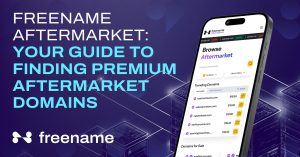
Freename is a platform that offers Web3 Top Level Domain Names (TLDs) and Second Level Domain Names (SLDs) that seem to be likely usable in many planned and future Web3 ecosystems and applications.
So to understand what a Web3 domain name is; we can break apart the domain name component and the Web3 component.
So what is a domain name?
A domain name is a common language pair of words separated by a “.” The left of the “.”, and the right of the “.” combine to make a domain name. Domain Names are easier to remember, easier to type and easier to verbally communicate then the numerical IP address, wallet address, or blockchain transaction that is referencing.
So domain names to date have been mainly in the public root managed by an organization called ICANN and for many years, this was the dominant platform where you could buy domain names on.
But for the past 25 years there have also been alternate root networks that perform the same function, offering domain name registrations outside of the ICANN public system. Recently, blockchain and other Web3 experiments and protocols have opened up larger and more prominent non-ICANN domain name systems.
But Back to Basics, a domain name is an easier to remember combination of words separated by periods that represent your identity or certain content or win WEB3 certain smart contract relationships. The natural language domain name (In ASCII/English and other languages, Emoji and IDNs) is easier to remember the hex address of your wallet, the IP address of your computer, or the numerical value of a blockchain transaction or other piece of private or public data, would be too burdensome.
So then you’re left with what is Web3?
Web3 is primarily defined as those applications that are decentralized, meaning that they’re not owned by one company but by various interested parties. These members of a network come together to maintain, manage, and provide order for different networks and systems.
The second component of many web 3 applications is that the information is stored on a blockchain. A blockchain and its simplest form is a series of unchangeable transactions which document who owns a cryptocurrency or token, a wallet for an nft or web 3 domain name, or other forms of content.
So instead of a single company owning a ledger or a database of all of its customers of all of its orders of all of its products, this list is captured on a blockchain where multiple people can submit data and the authority of nature of the data is determined by multiple people on the network confirming accuracy on the blockchain.
The reason domain names have adapted so well to the blockchain, is in many cases the way a domain name functions on the Internet is very similar to a blockchain. From the earliest days when your web browser goes to find the website that was entered into the browser bar, It used something called a domain name server (DNS) to ask the question of the ledger that keeps track of who owns every domain name and to which content or IP address it points. Then that DNS server returns a record which allows the browser to go find the content, send an email, or retrieve a picture or other piece of data.
So this idea that a browser is requesting a piece of data, and then receiving the reply, is very similar to someone looking up on a blockchain to see who owns a certain asset or cryptocurrency token, and then having that day to be confirmed and sent back to the requesting party.
Today the primary purpose of Web3 domain names has been to be an easier to remember wallet address, so instead of sending cryptocurrency or an NFT a to a long hard to recall and hard to remember wallet address you can simply have someone send your payment or NFT to your wallet which has a natural language domain name.
Plus some Web3 Domain Names can be just cool collectible to have and own, or to show off your Web3 Name to gain credibility, as a door opener or to tell people more about who you are and what image you’re trying to project in Web3.
Plus, new uses will come in the future involving potentially web 3 email, and smart contracts. We may also see Digital Identity applications (DIDs) where your digital identity can be kept private, but you can control what data and what features about your Web3 attributes.
The Legacy or public root of domain names became a source of giving out monopolies that could be worth billions of dollars, came with an entrenched legal framework not ready for Web3 and stifled competition with various closed silos, working groups and long drawn out decision making processes.
It wasn’t responsive enough to adapt to new domain names that can be used in these Web3 applications. So new companies have risen up to offer domain spaces that can be used by people in Web3 applications, in a more responsive and adaptive way than that which may have come from the public group.
This has meant that many strings that don’t have a regular public group domain name have been offered to the public as web 3 domain names. This is one of the things that Freename brings to its customers is your ability to not only get a domain name that’s easy to remember in an extension like. Metaverse, but also you can now be the owner of a top-level domain name, sign up for a royalties program and earn a 50% Revenue share whenever a domain name is sold on your top level domain.
BY PAGE HOWE







